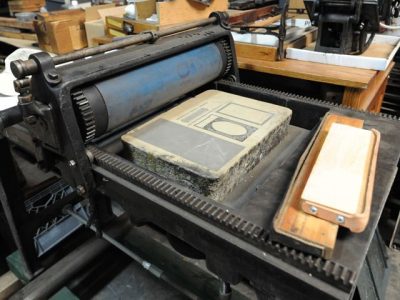Key Industries That Depend on litho printing Today
Key Industries That Depend on litho printing Today
Blog Article
A Comprehensive Guide to Understanding Litho Printing Techniques
The world of litho printing, a strategy stemming from the late 18th century, is an interesting blend of background, technology, art and science. This extensive guide will untangle the intricacies of this printing approach, from the make-up of litho inks to the challenges dealt with in modern applications. As we venture right into the details of lithography, the relevance of automation and sustainability in ensuring its future importance becomes progressively clear. Keep with us as we trip into the captivating world of litho printing.
The Historic Development of Litho Printing
The historical trajectory of litho printing, an essential advancement in the world of communication, is an exciting story of human resourcefulness. The process evolved with the arrival of the rotating press, which significantly enhanced efficiency. Each phase of litho printing's development showcases mankind's ruthless quest of performance and quality in aesthetic communication.
Translating the Science Behind Litho Printing Inks
Moving on in the expedition of litho printing methods, the focus currently changes to the scientific research behind litho printing inks. The structure of these inks, their drying procedure, and color mixing methods create the foundation of this complex art kind. Recognizing these aspects is critical to grasping the craft and achieving the preferred print results.
Composition of Litho Inks
In lithographic printing, the essential role of litho inks can not be overstated. Pigments, the color-providing components, are carefully ground particles suspended in the automobile, a liquid that carries the pigment onto the printing surface area. Each component plays an essential component in the final print's quality, making the specific formula of litho inks a complex science.
Ink Drying Process
From the make-up of litho inks, attention transforms to the fascinating process of ink drying. The drying process is important, as it influences the final print's high quality and long life. Two main methods are used in litho printing: oxidative drying and absorption. Oxidative drying out entails the ink responding with oxygen airborne to form a tough, dry film. This technique provides a long lasting finish, yet can be slower compared to absorption. Absorption, on the other hand, includes the ink permeating into the paper fibers, which is a quicker procedure but can cause much less vivid shades. The selection in between these techniques is reliant upon aspects such as print speed demands, the paper type used, and the desired finish.
Color Combining Methods
While the drying out procedure plays a key duty in litho printing, the scientific research of color blending strategies holds equal value. The science behind litho printing inks additionally takes right into account the openness of the ink, which impacts just how shades overlay and mix.
The Art and Design Components in Litho Printing
Litho printing takes a breath life right into art and style with its special elements. Litho printing suits a selection of shades, enabling musicians to create vibrant and vibrant prints. This mix of accuracy and adaptability makes litho printing a preferred selection for numerous artists and designers.
Modern Applications of Litho Printing Techniques
Litho printing methods have actually found extensive usage in the modern-day commercial field. Its impact and significance continue to grow with the arrival of new advancements and modern technologies in the area. This area will certainly discover these contemporary applications and the transformative function they play in the printing industry.
Industrial Litho Printing Utilizes
In today's electronic age, one might question the significance of standard printing techniques. Yet, litho printing stays a vital part of the commercial industry. High-volume printing jobs, such as the production of publications, papers, and packaging, depend on litho printing for its capability to supply premium image top quality and investigate this site cost effectiveness. The procedure, which includes transferring a tattooed photo from a plate onto a rubber covering and after that to the printing surface area, provides unrivaled uniformity. This makes it perfect for jobs calling for a large print run. Litho printing likewise provides a wide color spectrum, above that of digital printing. This makes it the best option for tasks that demand vivid, high-quality color recreation.
Developments in Litho Printing
Pushing the limits of conventional strategies, modern-day improvements have sustained a host of advancements in litho printing. These developments have not just boosted the top quality and effectiveness of litho prints however likewise broadened its application range. One noticeable development is digital litho printing, which integrates the virtues of electronic technology with litho's high-grade output. This crossbreed model uses faster configuration times, reduced waste, and allows on-demand printing. One more remarkable advancement is the intro More about the author of ecologically pleasant inks. These inks, made from veggie or soy-based services, have considerably reduced the market's ecological impact. litho printing. In addition, the advancement of innovative plate technology has structured the printing process, leading to sharper pictures and boosted color integrity. These innovations underscore the enduring significance of litho printing in the contemporary world.
Checking out the Process of Litho Printing: Detailed

Obstacles and Solutions in Contemporary Litho Printing

In spite of the accuracy and practice that litho printing happily promotes, it is not without its collection of modern challenges. Digital litho printing allows for cost-efficient short runs and very easy modification, resolving the issue of variable data. Therefore, while there are difficulties, the litho printing market is proactively adjusting to meet them head-on, ensuring its relevance in the future.
Conclusion
In conclusion, litho printing, with its abundant background and clinical complexities, holds a significant area in the print industry. The future of litho printing hinges on its capacity to adjust to these changing needs, affirming its long-lasting value in an evolving market.

Report this page